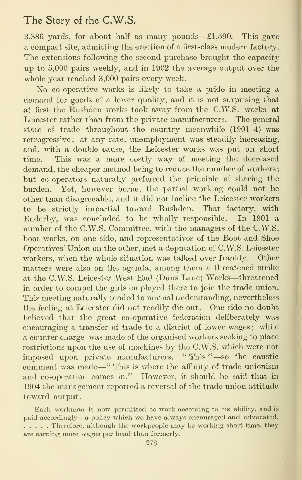Page 354 - The_story_of_the_C._W._S._The_jubilee_history_of_the_cooperative_wholesale_society,_limited._1863-1913_(IA_storyofcwsjubill00redf) (1)_Neat
P. 354
;
The Story of the C.W.S.
3,386 yards, for about half as many pounds—£1,590, This gave
a compact site, admitting the erection of a first-class modern factory.
The extensions following the second purchase brought the capacity
uj) to 5,000 pairs weekly, and in 1902 the average output over the
whole year reached 3,000 pairs every week.
No co-operative works is likely to take a pride m meeting a
demand for goods of a lower quality, and it is not surprismg that
at first the Rushden works took away from the C.W.S. works at
Leicester rather than from the private manufacturers. The general
state of trade throughout the country meanwhile (1901-4) was
retrogressive; at any rate, unemployment was steadily increasing,
and, with a double cause, the Leicester works was put on short
time. This was a more costly way of meeting the decreased
demand, the cheaper method being to reduce the number of workers
but co-operators naturally preferred the prmciple of sharing the
burden. Yet, however borne, the partial working could not be
other than disagreeable, and it did not incline the Leicester workers
to be strictly impartial toward Rushden. That factory, with
Enderby, was concluded to be wholly responsible. In 1901 a
number of the C.W.S. Committee, Math the managers of the C.W.S.
boot works, on one side, and representatives of the Boot and Shoe
Operatives' Union on the other, met a deputation of C.W.S. Leicester
workers, when the whole situation was talked over frankly. Other
matters were also on the agenda, among them a threatened strike
at the C.W.S. Leicester West End (Duns Lane) Works—threatened
in order to compel the girls emploj'ed there to join the trade union.
This meeting naturally tended to mutual understanding, nevertheless
the feeling at Leicester did not readily die out. One side no doubt
believed that the great co-operative federation dehberately was
encouraging a transfer of trade to a district of lower wages; while
a counter charge was made of the organised workers seeking to place
restrictions upon the use of machines by the C.W.S. which were not
"
imposed upon private manufacturers. " This —so the caustic
—
comment was made " This is where the affinity of trade unionism
and co-operation comes in." However, it should be said that in
1904 the management reported a reversal of the trade union attitude
toward output.
Each workman is now permitted to work according to his ability, and is
paid accordingly—a policy which we have always encouraged and advocated.
Therefore, although the workpeople may be working short time, they
are earning more wages per head than formerly.
278

